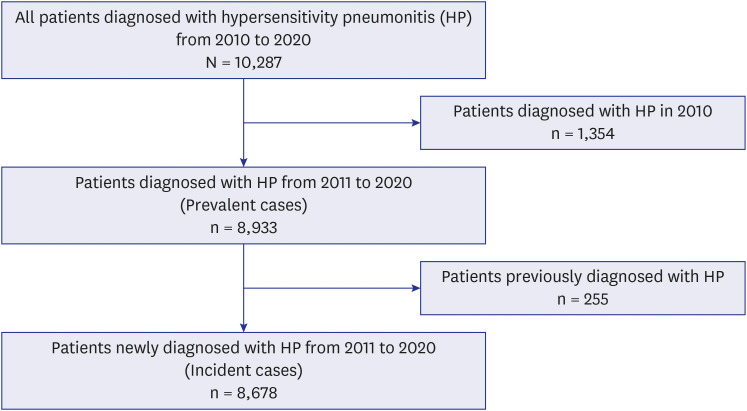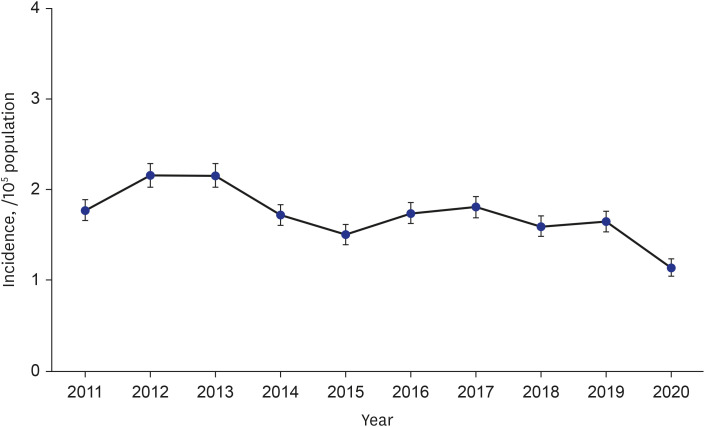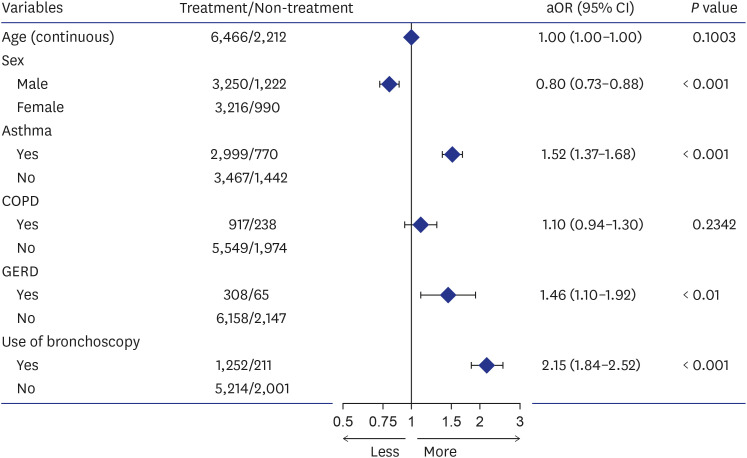J Korean Med Sci.
2024 Mar;39(10):e96. 10.3346/jkms.2024.39.e96.
Nationwide Study of the Epidemiology, Diagnosis, and Treatment of Hypersensitivity Pneumonitis in Korea
- Affiliations
-
- 1Division of Pulmonary and Allergy Medicine, Department of Internal Medicine, Chung-Ang University Hospital, Seoul, Korea
- 2Department of Internal Medicine, Chung-Ang University College of Medicine, Seoul, Korea
- 3College of Pharmacy, Chung-Ang University, Seoul, Korea
- 4Department of Global Innovative Drugs, Graduate School of Chung-Ang University, Chung-Ang University, Seoul, Korea
- KMID: 2554199
- DOI: http://doi.org/10.3346/jkms.2024.39.e96
Abstract
- Background
Hypersensitivity pneumonitis (HP) is a condition with an uncertain global incidence, and information on its diagnosis and management is limited. This study aimed to address these knowledge gaps.
Methods
This study utilized customized claims data from the Health Insurance Review and Assessment Service (HIRA) in South Korea from January 2010, to December 2021. Patients with HP were identified based on the diagnosis code (International Classification of Diseases, 10th Revision, J67) between 2011 and 2020. Incident HP cases were defined as new HP claims, excluding those with claims in the previous year. The study examined various factors such as age, sex, comorbidities, diagnostic methods, and treatment patterns. Additionally, multivariate logistic regression analysis was performed to identify risk factors associated with treatment initiation.
Results
A total of 8,678 HP incident cases were confirmed, with age- and sex-adjusted annual incidence rates ranging from 1.14/100,000 in 2020 to 2.16/100,000 in 2012. The mean age of patients with incident HP was 52 years, with a higher incidence observed among males. Additionally, the most common comorbidity was asthma. Bronchoscopy was performed on 16.9% of patients, and 25.4% of patients did not receive treatment within 1 year of diagnosis. Among those who received treatment, prednisone was the most used systemic steroid, and azathioprine was the most commonly used second-line immunosuppressant. Factors associated with treatment initiation included the female sex, having asthma or gastroesophageal reflux disease (GERD), and undergoing bronchoscopy.
Conclusion
This study provides valuable insights into the incidence, diagnosis, and treatment patterns of HP in South Korea using nationwide medical claims data.
Figure
Reference
-
1. Vasakova M, Selman M, Morell F, Sterclova M, Molina-Molina M, Raghu G. Hypersensitivity pneumonitis: current concepts of pathogenesis and potential targets for treatment. Am J Respir Crit Care Med. 2019; 200(3):301–308. PMID: 31150272.
Article2. Rittig AH, Hilberg O, Ibsen R, Løkke A. Incidence, comorbidity and survival rate of hypersensitivity pneumonitis: a national population-based study. ERJ Open Res. 2019; 5(4):00259-02018. PMID: 31649947.
Article3. Fernández Pérez ER, Kong AM, Raimundo K, Koelsch TL, Kulkarni R, Cole AL. Epidemiology of hypersensitivity pneumonitis among an insured population in the united states: a claims-based cohort analysis. Ann Am Thorac Soc. 2018; 15(4):460–469. PMID: 29236517.
Article4. Raghu G, Remy-Jardin M, Ryerson CJ, Myers JL, Kreuter M, Vasakova M, et al. Diagnosis of hypersensitivity pneumonitis in adults. An official ATS/JRS/ALAT Clinical Practice Guideline. Am J Respir Crit Care Med. 2020; 202(3):e36–e69. PMID: 32706311.5. Vasakova M, Morell F, Walsh S, Leslie K, Raghu G. Hypersensitivity pneumonitis: perspectives in diagnosis and management. Am J Respir Crit Care Med. 2017; 196(6):680–689. PMID: 28598197.
Article6. Salisbury ML, Myers JL, Belloli EA, Kazerooni EA, Martinez FJ, Flaherty KR. Diagnosis and treatment of fibrotic hypersensitivity pneumonia. where we stand and where we need to go. Am J Respir Crit Care Med. 2017; 196(6):690–699. PMID: 28002680.
Article7. Kim HK, Song SO, Noh J, Jeong IK, Lee BW. Data configuration and publication trends for the Korean National Health Insurance and Health Insurance Review & Assessment Database. Diabetes Metab J. 2020; 44(5):671–678. PMID: 33115211.
Article8. World Health Organization. ICD-10: International Statistical Classification of Diseases and Related Health Problems. Geneva, Switzerland: World Health Organization;2004.9. Wälscher J, Gross B, Morisset J, Johannson KA, Vasakova M, Bruhwyler J, et al. Comorbidities and survival in patients with chronic hypersensitivity pneumonitis. Respir Res. 2020; 21(1):12. PMID: 31918716.
Article10. Margaritopoulos GA, Antoniou KM, Wells AU. Comorbidities in interstitial lung diseases. Eur Respir Rev. 2017; 26(143):160027. PMID: 28049126.
Article11. Statistics Korea. The Korean Statistical Information Service (KOSIS). Updated 2024. Accessed February 8, 2024. https://kosis.kr .12. Solaymani-Dodaran M, West J, Smith C, Hubbard R. Extrinsic allergic alveolitis: incidence and mortality in the general population. QJM. 2007; 100(4):233–237. PMID: 17307752.
Article13. Bogaert P, Tournoy KG, Naessens T, Grooten J. Where asthma and hypersensitivity pneumonitis meet and differ: noneosinophilic severe asthma. Am J Pathol. 2009; 174(1):3–13. PMID: 19074616.14. Ghisa M, Marinelli C, Savarino V, Savarino E. Idiopathic pulmonary fibrosis and GERD: links and risks. Ther Clin Risk Manag. 2019; 15:1081–1093. PMID: 31564886.15. Kim KM, Cho YK, Bae SJ, Kim DS, Shim KN, Kim JH, et al. Prevalence of gastroesophageal reflux disease in Korea and associated health-care utilization: a national population-based study. J Gastroenterol Hepatol. 2012; 27(4):741–745. PMID: 21916988.
Article16. Fernández Pérez ER, Travis WD, Lynch DA, Brown KK, Johannson KA, Selman M, et al. Executive summary: diagnosis and evaluation of hypersensitivity pneumonitis: CHEST Guideline and Expert Panel Report. Chest. 2021; 160(2):595–615. PMID: 33865835.17. Zo S, Chung MP, Yoo HY, Lee KS, Han J, Chung MJ, et al. Clinical characteristics and outcomes of hypersensitivity pneumonitis in South Korea. Ther Adv Respir Dis. 2023; 17:17534666231212304. PMID: 37970818.
Article18. Kang J, Kim YJ, Choe J, Chae EJ, Song JW. Acute exacerbation of fibrotic hypersensitivity pneumonitis: incidence and outcomes. Respir Res. 2021; 22(1):152. PMID: 34016104.
Article19. Terras Alexandre A, Martins N, Raimundo S, Melo N, Catetano Mota P, Novais E Bastos H, et al. Impact of azathioprine use in chronic hypersensitivity pneumonitis patients. Pulm Pharmacol Ther. 2020; 60:101878. PMID: 31862300.
Article20. Morisset J, Johannson KA, Vittinghoff E, Aravena C, Elicker BM, Jones KD, et al. Use of mycophenolate mofetil or azathioprine for the management of chronic hypersensitivity pneumonitis. Chest. 2017; 151(3):619–625. PMID: 27816444.
Article21. Kondo T, Amano K. Era of steroid sparing in the management of immune-mediated inflammatory diseases. Immunol Med. 2018; 41(1):6–11. PMID: 30938261.
Article22. Fiddler CA, Simler N, Thillai M, Parfrey H. Use of mycophenolate mofetil and azathioprine for the treatment of chronic hypersensitivity pneumonitis-a single-centre experience. Clin Respir J. 2019; 13(12):791–794. PMID: 31464073.
Article23. Freedman PM, Ault B. Bronchial hyperreactivity to methacholine in farmers’ lung disease. J Allergy Clin Immunol. 1981; 67(1):59–63. PMID: 7451772.
Article
- Full Text Links
- Actions
-
Cited
- CITED
-
- Close
- Share
- Similar articles
-
- A case of hypersensitivity pneumonitis with positive precipitin antibody to Trichosporon cutaneum
- A Case of Gold Induced Hypersensitivity Pneumonitis Diagnosed by Lymphocyte Stimulation Test with Gold
- Hypersenstivity Pheumonitis
- Pneumonitis and pneumonia after aspiration
- Diagnosis, Clinical Course and Treatment of Hypersensitivity Pneumonitis




